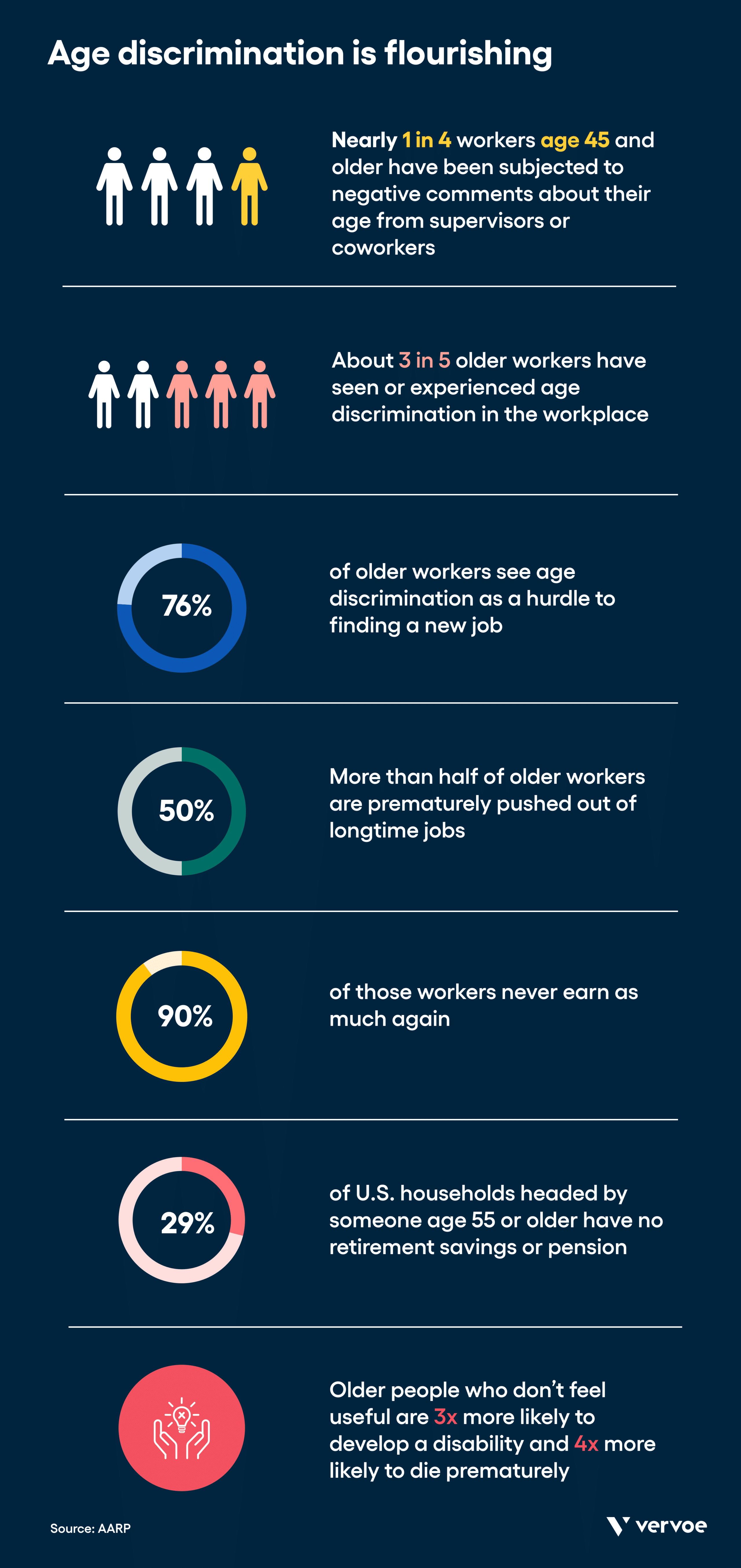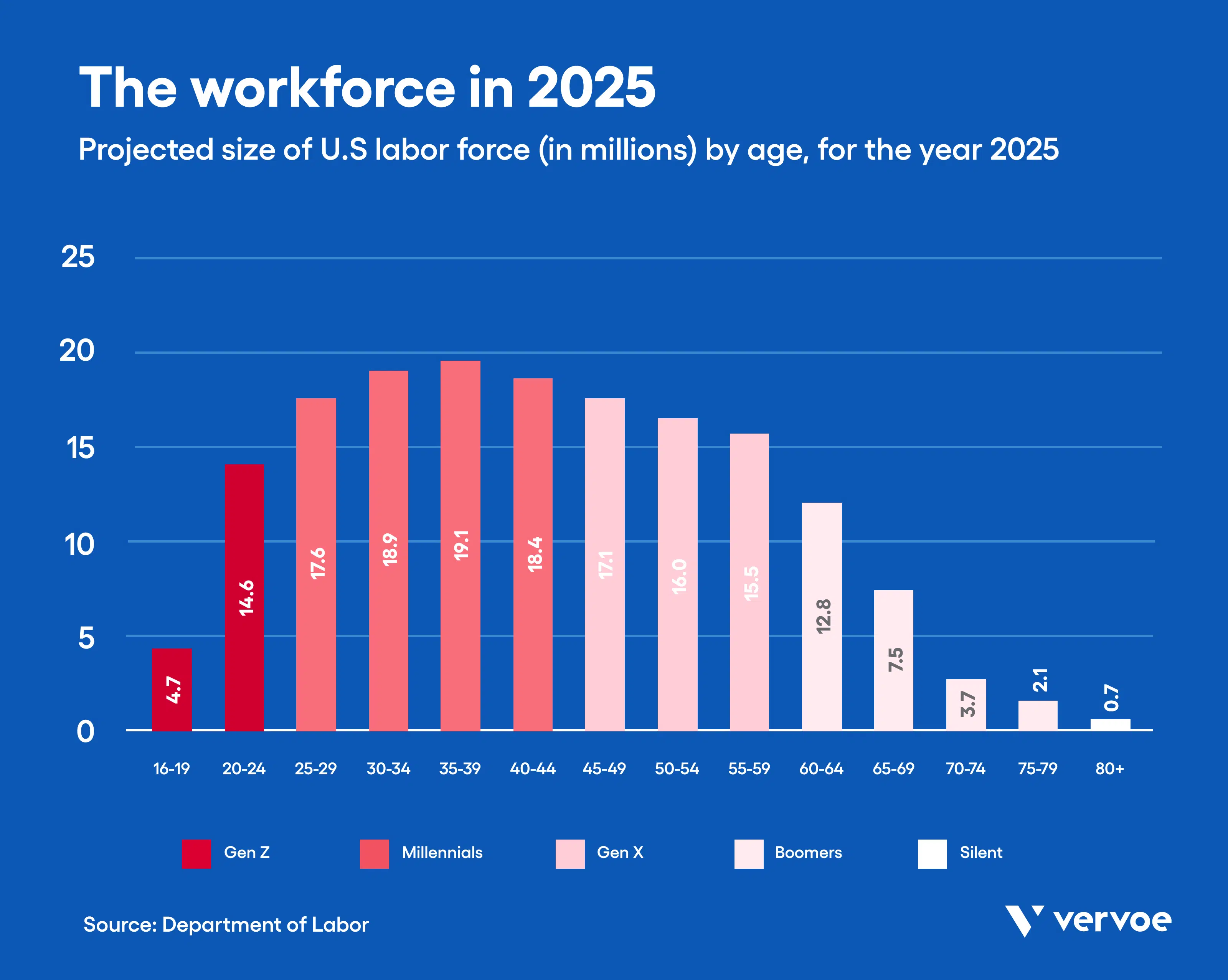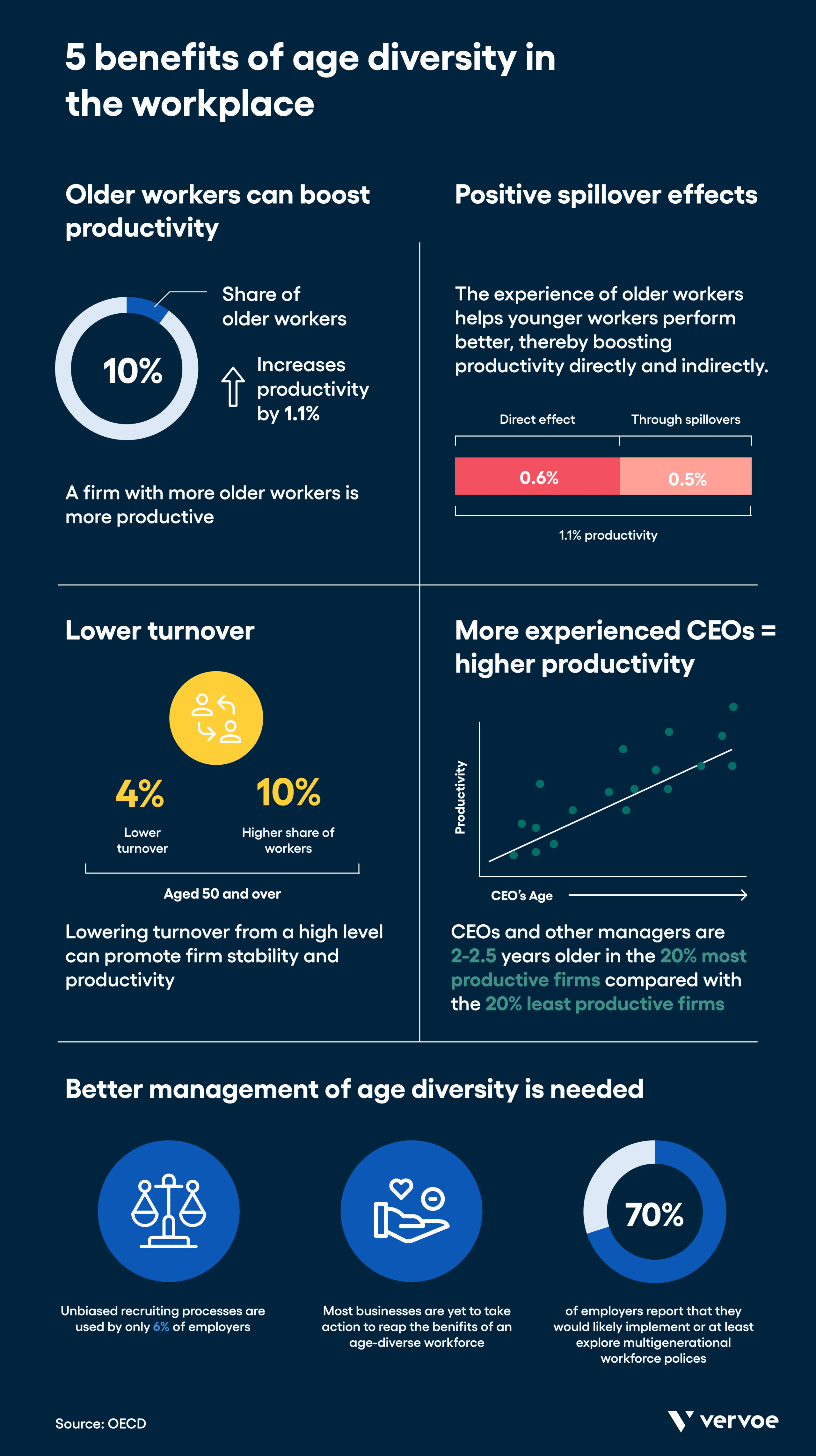Old people are slow and cranky, young people are entitled and lazy, and middle-aged people are square, right? Age-based stereotypes are applied to every generation in the workplace.
There’s a great episode of Seinfeld that illustrates these stereotypes perfectly. Jerry’s dad, Morty, is worried he may have to support Jerry. Morty takes a job working for Elaine, but Elaine quickly becomes annoyed by Morty — so she plays on Morty’s age to force him out.
This clip puts a humorous spin on a trend that’s taken root and is likely to remain for decades to come. Americans are leaving the workforce later, leading to greater age diversity in the workplace. When age discrimination legislation was first passed 50 years ago, only 40% of the workforce was over the age of 40. Today, those numbers have flipped: 54% of the workforce is over 50, with many people working and living much longer than previous generations.
Notably, Millennials — those aged 20-40 — make up the second-largest group of employees. This means that our labor force is more diverse than ever. Age diversity must be a priority for recruiters and business leaders, because, as we’ll demonstrate, age diversity benefits everyone.
What is age diversity in the workplace?
The age diversity definition is simply the acceptance of employees of different ages in the workplace. Age-based diversity is similar to generational diversity in that it seeks to combat age discrimination. The Age Discrimination in Employment Act (ADEA) makes it illegal to discriminate against people age 40 and older. Some states also have laws to protect younger workers from age discrimination.
Despite efforts — like the ADEA — to combat age-based discrimination, biases about age still persist. An EEOC summit in 2017 found that age discrimination remains a significant, and expensive, problem for workers, families, and society at large. Consider some of these age diversity statistics from AARP:
- Nearly one in four workers age 45 and older have been subjected to negative comments about their age from supervisors or coworkers
- About three in five older workers have seen or experienced age discrimination in the workplace
- 76% of these older workers see age discrimination as a hurdle to finding a new job; another report found that more than half of these older workers are prematurely pushed out of longtime jobs and 90% of them never earn as much again
- 29% of U.S. households headed by someone age 55 or older have no retirement savings or pension, meaning they’ll have to continue working or rely on Social Security to survive
- Older people who don’t feel useful are three times more likely to develop a disability and four times more likely to die prematurely, compared with counterparts who do feel useful, according to a 2007 study published in the Journals of Gerontology
The EEOC estimates that almost 1.5 million workers between the ages of 55 and 64 have dropped out of the workforce, some because their age was seen as a barrier to finding a job. Age discrimination prevents businesses of all sizes from tapping into a valuable source of talent.

What does age diversity look like in the workplace?
There are four main generations who are currently active in today’s workforce: Baby Boomers, Generation X, Millennials (e.g., Generation Y), and Generation Z.

Each of these generations has different strengths, preferences, and work styles that are determined by the world in which they grew up, their life stage, and their professional experiences.
[Read more: How To Embrace Generational Diversity In The Workplace]
Baby Boomers
Baby Boomers are roughly between the ages of 55 and 75. This generation of workers tends to seek advancement and be goal-oriented in their careers. They value in-person interaction and some structure, or hierarchy, in the workplace.
Generation X
Members of Generation X are currently between the ages of 40 and 60, roughly speaking. These employees are approaching the midpoint of their careers and potential peak-earning years. As the first generation to experience both parents working outside the home, these employees tend to be hard-working, adaptable, and digitally savvy.
Generation Y (Millennials)
Millennials are workers currently between the ages of 20 and 40. These employees are characterized as tech-savvy, achievement-oriented, and focused on using their professional careers to better the world. These workers seek to make their work mean something more than just a paycheck.
Generation Z
Generation Z is the youngest group in the workforce, currently between the ages of 18 and 25 (though, note that many members of Gen Z aren’t of the legal age to enter the labor market just yet). So far, this generation seems most motivated by salary. They are the first true digital natives, having never grown up without the internet. Gen Z is also one of the most diverse generations to enter the workforce in history.
Bringing members of all of these generations together can improve productivity, boost leadership, and help your business grow profitably.
5 benefits of age diversity in the workplace
Like other forms of diversity, improving age diversity has a direct impact on the success of your organization. The importance of age diversity in the workplace is demonstrated by its effects on employee engagement, retention, and motivation.
Here are some of the biggest advantages of age diversity in the workplace for businesses.

1. Increased productivity
Perhaps the biggest demonstration of how age diversity affects the workplace is the boost to productivity that businesses enjoy. Age diversity at work is shown to foster more productivity than less age diversity. For instance, simply by increasing the share of older workers by 10%, companies can generate a one-off gain worth slightly more than a year of growth.
This increase in productivity leads to a range of secondary benefits, including improved profitability, more competitive product pricing, better employer branding, and the opportunity to raise market share, according to the Organization for Economic Cooperation and Development (OECD).
[Read more: 6+ Powerful Benefits Of Diversity In The Workplace]
2. Improve skill diversity
Age diversity is like any other type of diversity: employees of different ages bring different skills, experiences, and viewpoints to the table, helping to increase innovation and creative problem-solving.
Employees of different ages bring different skill sets to the table. Younger generations may be more adept at social media and tech; older generations offer leadership, interpersonal skills, and their own approach to problem-solving. Age-based diversity policy allows businesses to harness all these diverse capabilities and build a team that complements one another.
3. Build an inclusive business
An inclusive business is one that supports and embraces people of all backgrounds. Inclusion in the workplace has become the expectation for job candidates and employees. Organizations that emphasize the inclusion of all ages, genders, and races are more innovative, more profitable, and better at problem-solving. Inclusive companies have an easier time learning about their customers, creating products and services that meet a market need, and communicating effectively.
[Read more: The 8 Best Inclusive Hiring Practices For 2021]
4. Create mentorship opportunities
Age diversity makes it easy to offer opportunities for your team to upskill collaboratively. Inter-generational mentoring (and reverse mentoring) can lead to rewarding career development and increase employee retention. Younger workers who may be well-versed in social media and emerging tech, for instance, can help less tech-savvy workers stay up to date. An older worker who has the wisdom of experience can take on a protege, mentee, or intern. This strengthens the company culture and loyalty among employees — as well as helps save on formal training costs.
5. Improve employee retention
Finally, age diversity in the workplace statistics show it helps improve employee retention. The EEOC found a strong correlation between age and employee engagement, saying “workers age 50 and older have the highest levels of engagement in the workplace”. Engaged workers are motivated workers who tend to stay longer with an organization. As a result of reassessing how to manage age diversity in the workplace, organizations benefit from lower recruiting costs as well as the retention of institutional knowledge.
How to promote age diversity in the workplace
Advancing age diversity in the workplace is no different than any other approach to building a diverse, inclusive workforce. Age diversity can be achieved with a combination of inclusive hiring practices and creating an employee experience that’s accessible to and supportive of everyone.
Create an age-inclusive hiring process
Age bias can be overcome with techniques such as blind hiring and skill testing. Removing age from hiring decisions, either by obscuring a candidate’s resume or using a tool like Vervoe, empowers recruiters to make their choices based on merit, rather than age.
Vervoe’s skills assessments software allows hiring teams to set up questions and assessments that mimic the tasks required from the new hire in the job they’re applying for. This assessment style allows candidates to perform tasks relevant to the role and showcase their abilities in the process. AI automatically ranks results, so recruiters receive a list of the top candidates after their qualifications have been validated. No personally identifiable details, other than a candidate’s name, impact this process.
And, candidates say that Vervoe is easy to use no matter how technologically savvy a candidate may be. Most skill assessments are mobile-friendly, which means that candidates can complete their tests anywhere and at any time.
Be strategic with your benefits
Attract age-diverse candidates with a benefits package that’s tailored to their specific lifestyle needs. For instance, Baby Boomers may be interested in companies that provide phased retirement programs, training and professional coaching, savings check-ups, and other financial support. On the other hand, Millennials are more likely to appreciate student loan repayment assistance, healthcare, and flexible work options. Make sure the diversity of your benefits reflects the diversity of your employees.
Provide thoughtful onboarding
Often, internships and apprenticeship programs are only open to new graduates or those with few years of experience. But, opening these types of opportunities, as well as revamping your onboarding process for new hires, can set employees of all ages up for success.
People miss out on learning specific skills for all kinds of reasons. Maybe their university didn’t offer coding courses. Or, maybe the employee is reentering the workforce after taking time off to raise a family — and missed learning the ins and outs of SEO in the meantime. Don’t assume everyone is starting from the same baseline. Require all employees to go through a tech onboarding session, customer service orientation, HR training, and any other onboarding sessions that will help all new team members thrive.
Build an inclusive work environment
Instead of characterizing members of your team as “old” or “young”, think about what stage of life each person is in and how you can support them. For instance, flexible work is one way to help employees of all ages. Parents need the flexibility to design their own workday around caretaking. Students may prefer working from home to allow them to finish a secondary degree. Older workers may have mobility issues, preferring to work from home rather than commute. Basing your work strategies to be able to work across different needs will make your company attractive to employees of all ages.
Final thoughts
Increasing age diversity can make a company more productive, innovative, and responsive to consumer needs. By catering recruiting, benefits, and onboarding to each employee’s needs, businesses can create the type of inclusive culture that captures the benefits of age diversity and provides a competitive edge. These strategies help employees of all ages thrive and prevent the need to schedule “late” meetings, a la Elaine Benes. Learn more about age diversity and other important hiring strategies in our guide, 25 Emerging Recruitment Trends In 2021. Check out our diversity recruitment software to learn how Vervoe can help improve diversity and inclusion the hiring process.




















